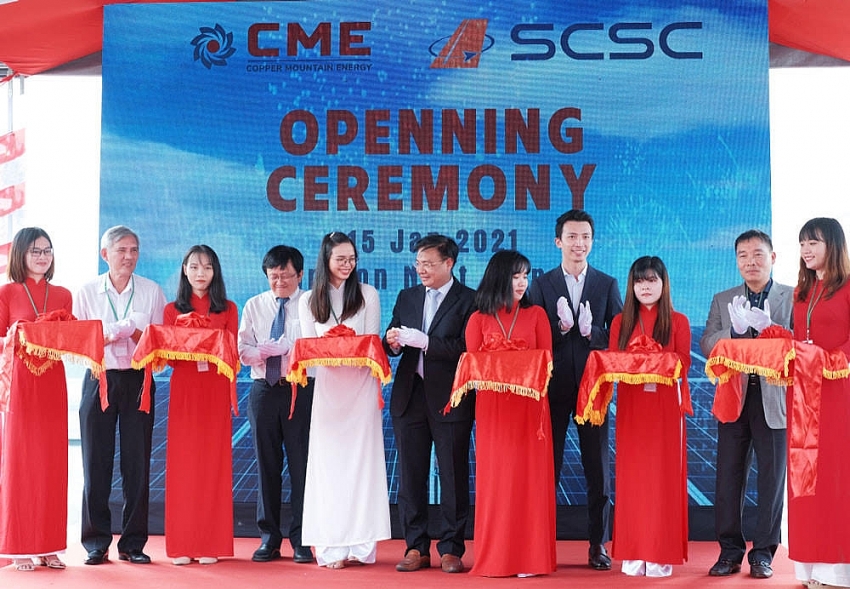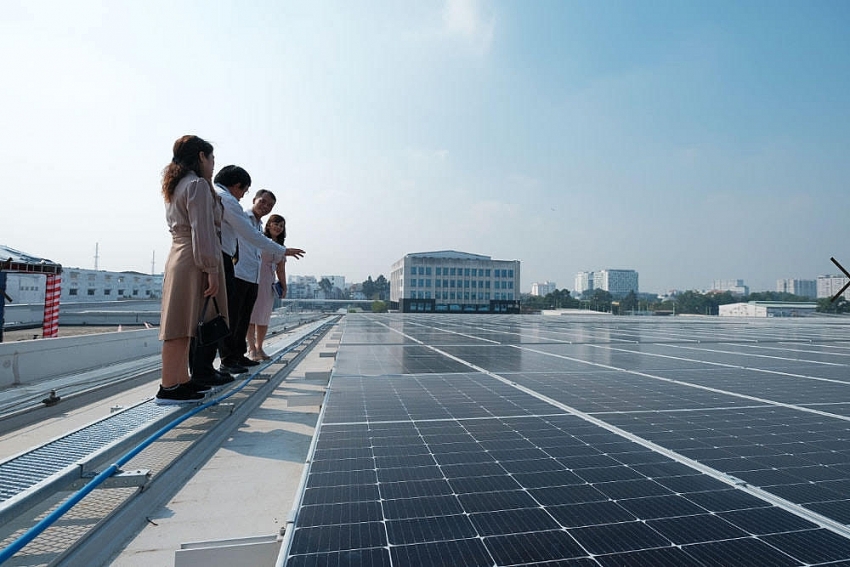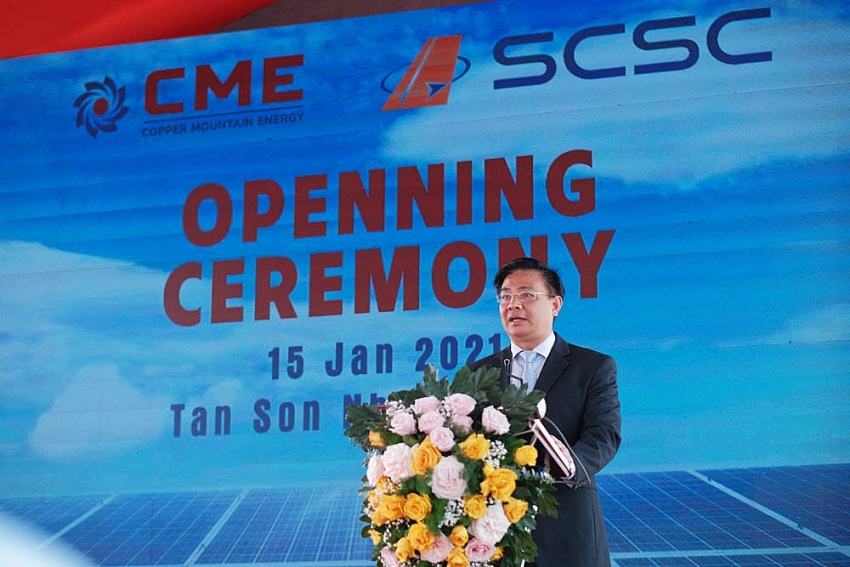New energy renewable and efficiency model applied at Tan Son Nhat Airport
 |
| Opening Ceremony of Industrial Rooftop Solar Energy System at SCSC - Cargo Terminal in Tan Son Nhat International Airport |
The industrial rooftop solar power system on the roof of Saigon Cargo Services Corporation (SCSC) has an installed capacity of 1.1MWp on an area of more than 7,500 square metres, is invested by Copper Mountain Energy JSC (CME). This is the first renewable energy project to be installed at an airport in Vietnam and the largest in the inner area of Ho Chi Minh City.
“CME, with our experience, reputation and capacity, have installed the rooftop solar power system on the warehouse system of SCSC under the 'full responsibility' model, including investment, installation, and operation costs,” said Bui Trung Kien, CEO of CME.
The features of an energy project serving the cargo operations of Tan Son Nhat International Airport require the investor (CME) to pay special attention to the design, construction, ensuring the highest quality, safety, and security.
 |
| CEO of SCSC Nguyen Quoc Khanh showing visitors the 1.1MWp rooftop solar system |
The project meets the rigorous accreditation requirements of AFRY (Sweden), one of the world's leading energy consultancy firms. The report from AFRY stated that for rooftop solar power projects like SCSC, construction at airports must not only ensure technical quality but also need to commit not to affect air traffic, security, and safety. The consultancy added that this was one of the few projects that they highly evaluate, meeting regional and international requirements.
“Technical criteria for design and construction of the operation, maintenance, and supervision systems include detection of potential failures that may affect system operation while electrical and fire safety are both reviewed and implemented with the highest quality,” technical director of CME Le Hong Quang noted.
 |
| CEO of CME Bui Trung Kien stressed that the project actively meets 40 per cent of SCSC's electricity needs, saving about 15 per cent of energy costs and reducing emissions by 1.5 tonnes of CO2 equivalents |
Remarkably, this is the first project in Vietnam that has been fully licensed regarding the design, review, and installation by the Ho Chi Minh City Police Department of Fire Fighting and Prevention.
Previously, Bui Trung Kien, deputy general director of Ho Chi Minh City Electricity Corporation (EVNHCMC) said: “So far, industrial and commercial rooftop PV systems’ capacity in Ho Chi Minh City has reached nearly 70MWp. Assessments show a potential generation capacity of nearly 1,500MWp, which means the room for solar power development in Ho Chi Minh City is huge. According to EVNHCMC, there were 8,762 grid-connected rooftop solar power systems in the city in 2020, including the residential sector.”
Currently, although EVN has suspended the connection of rooftop solar power projects to sell electricity to the grid to wait for further consideration of grid balancing, it does encourage business models where investors like CME and roof owners like SCSC produce and consume electricity on the spot.
In Ho Chi Minh City, especially in the inner city, there are very few enterprises with large roof areas like SCSC to deploy and install rooftop solar panels while electricity demand in the inner city (especially in Tan Binh district and the airport area) is very high, putting pressure on the city’s grid. Another plus point for this project is the emphasis on the "green economy" development model of Vietnamese enterprises for international visitors transiting and staying at Tan Son Nhat International Airport.
Energy industry experts attending the inauguration ceremony also said that to ensure energy security, Vietnam must quickly mobilise solar power. Rooftop solar power needs to be brought into Ho Chi Minh City, where electricity is needed the most.
According to SCSC, their electricity demand is about 3.7 million kW per year, and the operation of solar rooftop system is expected to help SCSC save VND1.5 billion ($65,220) a year in costs and about $1.4 million over the course of its 25 years of use while also generating significant savings on operating costs.
The SCSC-CME Industrial Rooftop Solar Power project is the first phase of a green energy plan between the two companies. The project will provide 1.5 million kWh of electricity annually, meeting 40 per cent of SCSC's electricity needs, saving about 15 per cent of energy costs, and reducing emissions by 1.5 tonnes of CO2 equivalents. The business will expand the second phase to achieve 100 per cent clean energy output.
According to Nguyen Quoc Khanh, general director of SCSC, they aim to develop SCSC to become a model aviation cargo terminal in Vietnam and the region, quickly applying renewable energy, utilising the available roof to save energy costs, and building a responsible business image, protecting the environment.
| CME aims to become a leading company in the renewable energy sector and contribute towards a low carbon economy with the goal to deliver 500MWp of purely rooftop solar power by 2025. So far, CME has worked with over 20 customers who are the leading local and FDI companies in their sector including global brands, major foreign-invested original equipment manufacturers, and leading Vietnamese companies in different sectors like footwear, textile and garment, construction materials, pharmaceauticals, food processing, and high-tech agriculture. These customers have a shared vision to create more sustainable business practices in Vietnam. They have a real willingness to do whatever it takes to help their clients consume as much green power as possible, all while paying lower electricity costs – a true win/win/win for customers, the environment, and investors. |
What the stars mean:
★ Poor ★ ★ Promising ★★★ Good ★★★★ Very good ★★★★★ Exceptional
Related Contents
Latest News
More News
- Heavy industries set for pilot greenhouse gas quotas (December 25, 2025 | 10:00)
- Swedfund invests in MSME growth and climate action in Vietnam (December 19, 2025 | 11:42)
- GreenYellow brings solar energy to light up remote schools in Tuyen Quang province (December 19, 2025 | 08:00)
- Charge+, Grab partner to develop EV charging network in Vietnam (December 18, 2025 | 17:11)
- Linking sci-tech and innovation to Vietnam’s net-zero future (December 18, 2025 | 14:31)
- Driving double-digit growth through green and circular transformation in Vietnam (December 17, 2025 | 09:00)
- Standard Chartered and ACCA deepen collaboration to develop Vietnam’s talent for a sustainable future (December 15, 2025 | 18:18)
- Schaeffler reports strong early output from Dong Nai solar project (December 12, 2025 | 15:16)
- Forestry conference highlights biodiversity and sustainability goals (December 09, 2025 | 13:35)
- Home Credit honoured among top 10 sustainable companies in trade and services (December 09, 2025 | 12:18)

 Tag:
Tag:




















 Mobile Version
Mobile Version